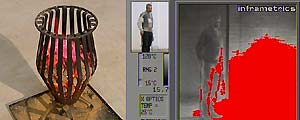Outdoor Heaters
Despite our wonderful climate, Australian’s have been slow to embrace the concept of extending indoor living areas outside. Even though the idea is catching on, most people still wouldn’t even consider dining alfresco during the winter months. However there’s no reason to let the cold weather stop you – install an effective heating unit and enjoy the great outdoors all year round!
We looked at some of the different types of outdoor heaters available and tested them under controlled conditions. We compared their prices, ease of operation, heat output, safety, maintenance requirements and fuel costs. Heat output profiles were measured at a distance of 1m (3′) from each unit, using a thermal imaging camera to produce a computer image of the scene. When seen through a thermal imaging camera, objects appear in different colours depending on their temperature: the blue areas are fairly cold, the blackish areas are intermediate and the red areas are very hot. We also compared radiant heat at 2m (6′) from each unit using a Thermo-hunter thermometer.
Chiminea (Mexican Fireplace)
Chimineas are wood burning heaters made from wood-fired, hand-pressed clay. There are two sizes available, large ($530) and small ($370). They are one of the cheapest of all the outdoor heating devices, costing about 50 cents per hour to run. When alight chimineas radiate character, ambience and warmth, and they have a terracotta look which makes them attractive features even when not in use. However, chimineas are dangerous to touch. The thermal imaging camera revealed that they produce most of the heat near ground level. This is a safety concern, particularly for young children. The Thermo-hunter reading for the chiminea was 35



